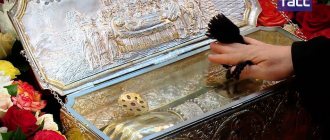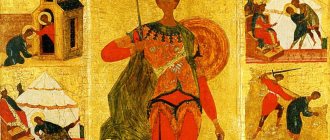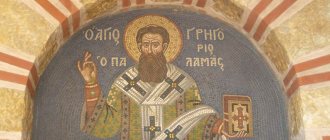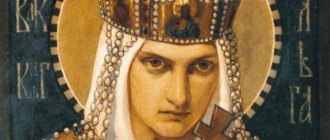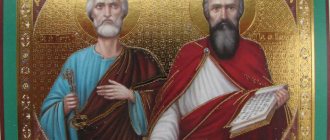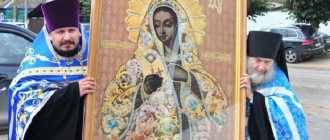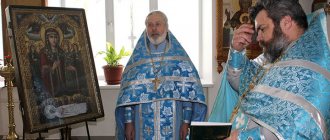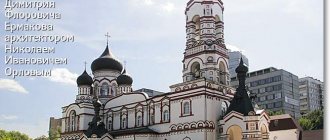Since ancient times, Saint Demetrius of Thessalonica has been considered the protector and patron of warriors. From the Orthodox Church he was awarded a special face of holiness - great martyr. One of the most revered icons of the righteous man (12th century) by Christians is located in the Tretyakov Gallery in Moscow. There he is depicted sitting on a throne.
In the Orthodox Church, it is customary to call saints who have endured especially severe torment for their faith in Jesus Christ great martyrs.
Great Martyr Demetrius of Thessalonica School or art. center: Mstera Second half of the 19th century. Wood, tempera. 31 × 26.5 cm Central Museum of Ancient Russian Culture and Art named after. Andrey Rublev, Moscow, Russia Inv. KP 4019
Troparion, kontakion, magnification
Troparion, tone 3
Great will you find in troubles/ the champion of the universe, O passion-bearer,/ the conquering tongues./ Just as you brought down Lieva’s pride,/ and you boldly created Nestor for the feat,/ so , Saint Demetrius, / pray to Christ God // to grant us great mercy.
Kontakion, tone 2
With your streams of blood, Demetrius, / God stained the Church, / giving you an invincible fortress, / and keeping your city unharmed // for this is your affirmation.
Greatness
We magnify you, passion-bearing Saint Demetrius, and honor your honest suffering, which you endured for Christ.
How does the icon of Dmitry Solunsky help?
One of the most revered icons in the Orthodox faith is the icon of St. Demetrius of Thessalonica. The Great Martyr is also called the Apostle Paul. He was deliberately killed after he publicly declared that he was a Christian. In this article you will learn briefly about the life of the saint, as well as the meaning of the icon and how it helps.
Brief Life
The Great Martyr Dmitry was born in Greece in the wonderful city of Thessaloniki, at a time when the wicked kings, the God-fighters Diocletian and Maximian, ruled.
His parents could not have children for a long time. Being secret representatives of the Christian faith, they prayed to the Lord for a long time for help in conception. One day the Lord heard them and gave them a son. When Dmitry grew up, his parents secretly called a priest and baptized him.
Throughout his life, they instructed the boy in faith. Dmitry's father was a Roman proconsul. When his son turned 18, his father died. Emperor Maximian Galerius appointed Dmitry to replace his father as governor. His duties included defending the Thessalonian region and exterminating Christians. Instead, he began to exterminate pagans and began to preach the Christian faith.
When the emperor found out about this, he locked Dmitry in prison. But while sitting in prison, Dmitry did not renounce his faith; on the contrary, he began to glorify God even more. At that time, Emperor Maximian entertained himself and the citizens by holding a circus and fighting in the arena with gladiators. When his most powerful gladiator in the arena was killed, he became very angry and ordered the execution of the one who defeated him.
But this did not quench his anger. After which he ordered the execution of Saint Dmitry. On the morning of October 26, 306, soldiers entered the prison to take the righteous man to execution. When they saw him standing in an attitude of prayer, they immediately pierced him with spears.
His body was thrown out to be devoured by wild animals, but the townspeople buried him secretly. After the burial, Dmitry's servant Lupp took the bloody robe and the martyr's ring and began to heal the sick with them, for which he was executed by the emperor.
During the period 324 - 337. A temple was built over the grave of the great martyr. Many healings took place there. Later the relics of the saint were also found.
Meaning of the icon
This icon is a strong amulet for all warriors. It is of great importance for all of Rus', as is the significance of the icon of Dmitry Donskoy. These two holy images are a symbol of courage and bravery. In ancient times, even the tsar himself was present during the service at the icon.
In memory of the soldiers who fell on the Kulikovo field, Dmitrievsk Parental Saturday was established for church-wide commemoration. Since then, it has been customary to venerate the icon of St. Dmitry on the day of remembrance of parents and on October 26, the day of transfer of the relics. And for the first time, this memorial service took place on October 20 in 1380.
What does the icon of Dmitry of Thessalonica help with?
Today, particles of the relics of the great martyr are found in different countries of the world. Six of them are in Italy. At the relics and at the icon of St. Demetrius it is customary to pray for:
- healing from eye diseases,
- healing from serious illnesses,
- about courage
- about patience
- about courage.
It must also be said that by purchasing the image of St. Demetrius, you protect your home from various ill-wishers.
The text of the prayer to the saint is as follows:
Holy and glorious Great Martyr of Christ Demetrius, quick helper and warm intercessor of those who flow to you with faith! Standing boldly before the Heavenly King, ask Him for forgiveness of our sins and to free us from the all-destroying plague, cowardice, flood, fire, sword and eternal punishment. Pray for His goodness to show mercy to this city, this monastery and every Christian country.
Seek from the King of the Reigns victory and victory over the enemies of the Orthodox Christians, the entire Orthodox Empire for peace, silence, firmness in faith and advancement in piety; for us, who honor your honorable memory, ask for grace-filled strengthening for good deeds, so that our Lord Christ God works here with grace, we may be worthy through your prayers to inherit the Kingdom of Heaven for His eternal glorification with the Father and the Holy Spirit. Amen.
May the Lord protect you!
You will also be interested in watching a video about the icon of St. Demetrius:
What does a saint help with?
The miraculous remains of the saint are kept in different countries, including Russia. For example, in the Church of the Great Martyr in St. Petersburg in Kolomyaga and in the church in the village of Vostochny in Moscow.
It is believed that a righteous person helps in the following cases:
- Relieves eye, head and other ailments.
- Helps warriors.
- Gives courage and bravery.
- Strengthens faith in God, supports in moments of disappointment.
- Supports during hunger/in everyday difficulties.
- Helps in epidemics.
- Cures obsession.
Nowadays, military personnel and their relatives often turn to the great martyr. Especially during wars, serving in hot spots. They pray to him to preserve peace and strengthen the strength of spirit.
Author: Natalya Dormidontova
History of the relics
Reliquary with the relics of St. Demetrius of Thessaloniki, Thessaloniki
According to the life, after the execution of Demetrius, his body was thrown to be devoured by beasts, but they did not touch him and the remains were buried by Thessalonica Christians. In the 4th century, the first church in his honor was built over the grave of the saint in Thessaloniki - the Basilica of St. Demetrius. A hundred years later, in 412-413, the Illyrian nobleman Leontius, in memory of his deliverance from paralysis, built the first large church between the ancient baths and the stadium that had turned into ruins. The altar part of the built church was located above the supposed burial place of the saint, and during its construction the relics of St. Demetrius were found.
The relics were placed in a silver ciborium. It had a hexagonal base, blank walls and a roof topped with a cross. Inside there was a silver box with the image of the saint's face. Believers could go inside and light candles in front of it. The description of the ciborium was made by the Thessalonian Archbishop John in the middle of the 7th century, and its image was also on the mosaic of the northern colonnade of the basilica (known only from watercolors by the English architect W. S. George). The precious ciborium was lost in a fire in the 7th century.
After this, the relics were placed in a marble tomb. Presumably at the end of the 12th - beginning of the 13th century, perhaps during the existence of the Latin kingdom of Thessaloniki, they were taken from Thessaloniki to Italy. The relics were discovered in 1520 in the abbey of the city of San Lorenzo in Campo and returned back to Thessaloniki only in the 20th century: in 1978 - the honest chapter, and in 1980 - the main part of the holy relics (six large particles remained in Italy) .
The life of Saint Demetrius of Thessalonica describes episodes when he forbade separating parts from his relics. So an Illyrian nobleman named Leonty decided to take part of the saint’s relics from Thessalonica in order to build a church in his city in honor of St. Demetrius. But the saint, appearing to him, forbade separating part of his relics. Then Leonty took only the shroud, stained with the blood of Saint Demetrius. Also, the Byzantine Emperor Justinian I decided to have part of the saint’s relics in the Church of Hagia Sophia in Constantinople, which he built. When the messengers approached the ark with the relics of Saint Demetrius, a column of flame burst out of it and a voice was heard from the fire, forbidding them to take the relics. Then the messengers took only a little land from this place.
Myrrh-streaming
A shell for collecting myrrh in the crypt of the Basilica of St. Demetrius. The
relics of St. Demetrius have been revered since ancient times as myrrh-streaming (Dimitri of Rostov reports that myrrh-streaming has been known since the 7th century, but John Skylitzes was the first to write in writing that myrrh-streaming first appeared in 1040). Believers who came to the basilica to venerate the saint collected myrrh into glass ampoules, the earliest of which date back to the 11th-12th centuries. Myrrh was revered not only by Christians. John Anagnost, who described the capture of the city by the Turks, reports that Muslims also collected myrrh, considering it a medical drug for any disease.
We advise you to study Prayers against pride and conceit
From the 14th century, instead of the flow of myrrh-oil from the relics, references began to be made to the flow of myrrh-water from the well in the crypt (the first written mention was made in 1330 by Nikifor Grigora). At the same time, when the relics disappeared from the temple, a legend arose that they were hidden in a well located in the crypt. Mention of the flow of myrrh from the well ceased in 1493, when the basilica was turned into a mosque (Orthodox people retained access for worship to the cenotaph of St. Demetrius, which remained after the disappearance of the relics).
In ancient times, the flow of myrrh was very abundant - Nikita Choniates describes how the Normans, who captured Thessaloniki in 1185, blasphemously collected myrrh into pots, fried fish on it and smeared their shoes with it. Now the myrrh-streaming of the relics has stopped. The shrine of St. Demetrius is opened at Vespers on the eve of the saint’s feast day and the faithful are given cotton wool soaked in an aromatic liquid that is not identified with the world about which Demetrius Chrysologos wrote in the 14th century.
Blood of a Saint
The cult of the blood of the great martyr arose already in the early Christian period (see above the story of the slave Luppa). During excavations in the altar of the Basilica of St. Demetrius, a glass vessel with dried blood was discovered under the altar in a cruciform recess in a marble ark. It is believed that the tomb of St. Demetrius was originally located under the altar, which, according to some researchers, contained soil mixed with blood in the Middle Byzantine period. Relics of the 11th-12th centuries with the blood of the great martyr (in the Great Lavra of Athos), with bloody earth (in the Vatopedi monastery of Athos), as well as with blood and peace (encolpion of the 12th-13th centuries in the British Museum) have been preserved.
Help coming from the image
People turn to the saint at those moments in life when faith begins to weaken and disappointment sets in.
- Prayer in front of the miraculous icon helps heal eye diseases and headaches.
- Military personnel turn to Reverend Dmitry if relevant problems arise with the environment.
- The holy image helps a person gain courage; they ask him for protection in hot spots, where the military is haunted by the feeling of imminent death.
- Demetrius of Thessaloniki, hearing a sincere prayer, is able to bring peace and prosperity to a particular region.
Hagiographic icon of Demetrius of Thessalonica
The life of the saint tells of several stories when he performed miracles that glorified the Almighty Creator.
- One resident of the city of Thessalonica led an unrighteous life, which led to a serious illness. Doctors could not save the unfortunate man from a painful death; some suggested that he turn to the Magi, but the patient refused to betray his own faith. At night, the Monk Dmitry appeared to the resident and ordered him to go to the temple. The unfortunate man spent the allotted time in the church, and in the morning he felt healed.
- The chronicler John writes about a terrible epidemic in Thessaloniki, which claimed a colossal number of lives. The residents, overwhelmed with grief, in despair prayed to the saint for help. Tradition says that people who spent the night in the temples escaped a terrible death, but the rest died.
- There is evidence that one Greek warrior succumbed to the influence of demons. The unfortunate man was not able to ask for help from the holy icons. Relatives took him to the temple, consecrated in honor of the Great Martyr Dmitry, and locked the patient here for the night. In the morning, the warrior regained his sober mind and got rid of the demonic obsession.
Interesting!
During the period of early Christianity, the cult of the blood of the holy martyr Dmitry of Thessalonica appeared. When excavations were carried out in the altar part of the saint's temple, researchers discovered a glass vessel containing dried essence. Tradition says that it was under the altar that the tomb of the venerable warrior was located. Various cathedrals contain vessels with bloody earth and peace, discovered from the 11th to the 13th centuries.
Worship and the essence of prayers
The ancient Slavs repeatedly attacked Thessaloniki, but they were always faced with a frightening and awe-inspiring vision of a formidable young man guarding the central gates of the city. The traditions of veneration reached the ancestors who lived during the period of the baptism of Rus' and highly revered the great intercessor of Christianity.
- At the end of the 12th century, Prince Vsevolod of Vladimir built the Demetrius Church, which is still considered a significant landmark of the city. The miraculous icon of the holy martyr, kept in the church for a long time, is today in the Tretyakov Gallery.
- In 1280, Daniel of Moscow erected a stone cathedral, consecrated in honor of St. Thessalonica. However, after 50 years the building was dismantled and replaced by the Assumption Cathedral.
- Despite the fact that Dmitry was born in Greece, from ancient times he was considered the patron saint of our Fatherland and all its defenders.
Icon "Demetrius of Thessalonica on horseback"
There is a prayer with which an Orthodox person can address a holy martyr. At the beginning, Dmitry is called a warm intercessor and a quick helper to all who believe in the One God. The man asks the saint to ask the Lord for forgiveness of all sins and goodness in every Christian home. The prayer ends with the words that true believers will definitely gain the Kingdom of God.
More about prayer:
- Prayer of repentance and forgiveness of sins
- Prayer for those who offend and hate
- Cell prayer of John Krestyankin
Shrines
- the relics of the martyr. Demetrius of Thessalonica (IV century)
- martyr icon Demetrius of Thessalonica
- relics mts. Anisia (IV century)
- relics of St. Gregory of Irakli (XX century)
- particle of the relics of the martyr. Euthymius the New, Thessalonica (10th century)
- head of mts. Helena (XVIII century)
- head of the prmch. Demetrius of Tripoli (XIX century)
Relics of Saint Demetrius
The basilica, built on the site of the martyrdom of St. Demetrius, from its very foundation was a repository of relics associated with this saint. Initially, the central place in the cult of Saint Demetrius was occupied by his ciborium, which in the life and miracles of the saint is described as the place from where the saint communicated with believers. Later, the emphasis shifted to the veneration of the saint’s relics, which from the mid-11th century were venerated as myrrh-streaming ones.
Relics of the Saint
Currently, the relics are kept in the northern nave of the basilica in a marble ciborium, created to replace the silver one lost in a fire in the 7th century (this is the second marble ciborium of St. Demetrius, the first was destroyed in 1430 when the city was captured by the Turks). Presumably at the end of the 12th - beginning of the 13th century, perhaps during the existence of the Latin kingdom of Thessaloniki, they were taken from Thessaloniki to Italy. The relics were discovered in 1520 in the abbey of San Lorenzo in Campo and returned back to Thessaloniki only in the 20th century: in 1978 - the honest chapter, and in 1980 - the main part of the relics (six large particles remained in Italy).
Since ancient times, the relics were revered as myrrh-streaming (Dmitry of Rostov reports that myrrh-streaming has been known since the 7th century, but John Skylitzes was the first to write in writing that myrrh-streaming first appeared in 1040). Believers who came to the basilica to venerate the saint collected myrrh into glass ampoules, the earliest of which date back to the 11th-12th centuries. Myrrh was revered not only by Christians. John Anagnost, who described the capture of the city by the Turks, reports that Muslims also collected myrrh, considering it a medical drug for any disease.
From the 14th century, instead of the flow of myrrh-oil from the relics, mention began of the flow of myrrh-water from the well in the crypt (the first written mention was made in 1330 by Nikephoros Grigoras). During the same period, due to the disappearance of the relics from the temple, a legend arose that they were hidden in a well located in the crypt. Mention of the flow of myrrh from the well ceased in 1493, when the basilica was turned into a mosque (Orthodox people retained access for worship to the cenotaph of St. Demetrius, which remained after the disappearance of the relics).
In ancient times, the flow of myrrh was very abundant - Nikita Choniates describes how the Normans, who captured Thessaloniki in 1185, blasphemously collected myrrh into pots, fried fish on it and smeared their shoes with it. Although the myrrh-streaming of the relics has now stopped, the saint’s reliquary is opened at vespers on the eve of the saint’s day of remembrance and the believers are given cotton wool soaked in an aromatic liquid that is not identified with the world about which Demetrius Chrysologus wrote in the 14th century.
Blood of a Saint
The cult of the blood of the great martyr arose already in the early Christian period (Demetrius of Rostov reports that Lupp, a servant of St. Demetrius, “reverently took the robe of his master, sprinkled with his honest blood, in which he soaked the ring. He performed many miracles with this robe and the ring”). During excavations in the altar under the altar, a glass vessel with dried blood was discovered in a cross-shaped recess in the marble ark. It is believed that under the altar the tomb of St. Demetrius was originally located, in which, according to some researchers, in the Middle Byzantine period there was earth mixed with blood. Relics of the 11th-12th centuries with the blood of the great martyr (in the Great Lavra on Athos), with blood-soaked earth (in the Vatopedi monastery on Athos), as well as with blood and peace (encolpion of the 12th-13th centuries in the British Museum) have been preserved.
Life of Demetrius of Thessalonica
The saint was born in the third century after Christ
. Then it was a particularly difficult time for Christians: for the open confession of Jesus Christ as God from the pagans and polytheists, the brave souls were threatened with certain, most often painful, death. Therefore, Christians hid their faith, that is, they were “secret.”
The parents of Saint Demetrius were such secret Christians. The future saint was baptized in a secret church, which was located inside the house itself. The boy was raised in the Christian faith. After the death of his father, Saint Demetrius received the position of ruler of the Greek Thessaloniki. Guided by zeal for the Christian faith, he began to openly spread Christianity and teach the true religion of the Thessaloniki inhabitants, who were mostly idolaters.
Soon the emperor received a denunciation that his proconsul Demetrius was an ardent Christian
. The emperor was offended and ordered Saint Demetrius to be taken into custody and imprisoned. Demetrius knew that he was in danger of death, and began to prepare in advance. He distributed his property to the poor, and he devoted himself to fasting and prayer. In prison, he was honored with a visit from the Angel of Christ, and this led to the prisoner’s desire for martyrdom even more.
Maximian stopped in the city of Thessaloniki, returning from a military campaign. The ruler, having imprisoned his proconsul, decided to teach the inhabitants of the city a lesson and entertain himself with gladiator fights. Maximian's men were looking for Christians and dragging them into the arena. The famous fighter Liy easily defeated meek Christians in battle and, while the frenzied crowd rejoiced, threw them off the platform onto spears.
A young man named Nestor
, who was a pupil of Saint Demetrius of Thessalonica, came to prison to listen to his instructions. The young man, no longer wanting to see Liy kill many beautiful and kind people, decided to engage in a duel with the bloodthirsty killer. He went to Demetrius in prison and asked for his prayers and blessings for this matter.
We advise you to study Prayer to the Blessed Virgin Mary for the family
The saint crossed him and prophetically said that the young man would defeat Leah and accept martyrdom. The young Christian, supported by the almighty power of the Holy Trinity, defeated Leah and threw him off the platform onto the spears.
When the ruler Maximian called Nestor to answer what kind of sorcery he used to defeat such a skilled warrior, he answered directly that the gladiator was defeated by an angel who was sent by the “God of Demetrius.” Nestor to be executed without delay.
.
Realizing that it was through the prayers of Demetrius that the young man was able to win, Maximian ordered him to be put to the same death as Leah was killed: the saint was tortured with spears. Demetrius's servant named Lupp collected the blood of the great martyr onto a cloth and dipped a ring belonging to the new saint into it.
Soon miracles of healing began to emanate from these objects. Word about them quickly spread throughout Thessaloniki, people came to honor the memory of the saint and receive the necessary help. The emperor found out about this and ordered the execution of Lupp. The body of Demetrius, like-minded people of the former proconsul, was buried out of fear of the ruler in the same place where he met his martyrdom. Many signs and wonders were performed at the place of death of Demetrius of Thessalonica, and now the glory of the great martyr spread throughout Thessaly and Macedonia.
Iconography
In the icon, Demetrius of Thessaloniki is represented sitting on a throne with a crown on his head. In his hands is a sword, half drawn from its sheath. In the upper left corner of the icon there is a figure of Jesus Christ against the background of a cloudy sky, and in the upper right corner there is an angel bearing the martyr’s crown to Demetrius.
The icon has suffered greatly from time and records. What has been preserved from the original painting of the 12th century is: the image of the Savior in the clouds, the head, the right hand with a sword, the torso, the left arm to the elbow, the vest and legs to the feet of St. Demetrius. The remaining parts of the image of the saint, the flying angel and the throne date back to the 14th-16th centuries. Initially the icon had a silver background. When the icon was unveiled in the 1920s, the original 12th-century image of a cinnabar gaitan with encolpium, located on the saint’s neck, was destroyed, which was erroneously attributed to a later recording.
Regarding the image of Saint Demetrius on the icon, Academician V.N. Lazarev points out that “ the artist apparently wanted to emphasize the spiritual fortitude of the warrior and his fearlessness. The monumental, calm figure is full of strength; in the gesture of the right hand, taking the sword out of its scabbard, one feels enormous inner composure
».
The icon is written on a linden board. An ancient dowel, nailed to the upper end with wooden nails, has been preserved. On the back side of the icon there are mortise keys of late origin. The icon board has an ark, and a piece of cloth is glued to it.
Dmitrov icon of the 12th century
One of the most famous icons of Dmitry of Thessalonica, where he is depicted sitting on a throne, dates back to the second half of the 12th century. Since 1930, it has been kept in Moscow, in the State Tretyakov Gallery.
Dmitry Solunsky on the throne School or art. center: Vladimir-Suzdal school End of the 12th century. Onasch 1961: XII century. Antonova, Mneva 1963: Second half of the 12th century. Rostov-Suzdal painting 1970: End of the 12th century. Tretyakov Gallery 1995: The end of the XII - the beginning of the XIII centuries. Lazarev 2000/1: The end of the 12th century. 156 × 108 cm State Tretyakov Gallery, Moscow, Russia Inv. 28600 From the Assumption Cathedral in Dmitrov.
According to legend, the Grand Duke of Novgorod Vsevolod the Big Nest brought the shrine to Dmitrov. And already at the beginning of the 20th century, after the revolution, it was discovered in the local Assumption Cathedral.
At the same time, the ancient image on the icon was restored, where Dmitry sits on a throne, his head is decorated with a crown, and in his hands he holds a half-naked sword. The Lord looks at the saint from heaven, and an Angel bears him the crown of a martyr.
A sword in the hands of a righteous man is considered to be a symbol of courage and bravery. It is also interpreted as the Word of God, with which the saint was armed during his lifetime. Art critics note that the figure of the great martyr on the icon is full of strength, fearlessness and demonstrates the spiritual fortitude of the saint.
The Life of the Holy Blessed Prince Dmitry Donskoy
In 1359, his father died when Dmitry was 8 years old, and he became the Grand Duke of Vladimir and Moscow. Saint Alexy actually replaced his father for a long time, until his death in 1378.
As a 9-year-old boy, Dimitri went to the Horde and received permission from the khan to inherit his father’s reign. Dimitry Donskoy was a pupil of St. Alexy of Moscow.
As already noted, in Orthodoxy Dmitry Donskoy is considered the patron saint of marriage. However, he had never even seen Evdokia before marriage - it was a marriage of convenience. Sergei Radonezhsky helped in choosing a wife. The alliance with Suzdal was supposed to help Moscow strengthen on the Nizhny Novgorod side. At the time of marriage, he was 16 years old, and the bride was only 13 years old.
Many believe that this marriage owes much of its extraordinary harmony to the meek disposition of Prince Dmitry. He inherited his love of peace from his father, nicknamed “The Meek” for his diplomatic approach. Subsequently, his mentors, Metropolitan Alexy of Moscow and Abbot Sergius of Radonezh, helped him develop this character trait.
For his decisive historical Battle of Kulikovo, the blessed Prince Dimitri received a blessing from the great Saint Sergius of Radonezh. The Monk Sergius gave the faithful warrior Demetrius his schema-monks Alexei and Alexander as assistants.
The Battle of Kulikovo was valiantly won by Grand Duke Dimitri. The history of the Russian army has never known such a victory. The Don River flows next to the Kulikovo Field, which is why the winner of the battle of Dimitri began to be called Dimitri Donskoy.
God's chosen one was brought up in virtue and purity from infancy, absorbing the atmosphere of Christian morality. Never again will the great ruler deviate from the tenets of Orthodoxy.
Boundless trust in God, strict fasts, prayerful and spiritual deeds were combined with mercy and charity, care for his subordinates and the Russian people.
Dmitry Donskoy died young - he was not even 39 years old - just a few days after the birth of his youngest son.
Who blessed Dmitry Donskoy for the Battle of Kulikovo
Contemporaries honored the noble prince as a fearless and wise commander. Crushing victories over the Horde gave hope of getting rid of the long-term yoke.
But Saint Dmitry Donskoy did not begin a single business without God’s guidance. And therefore, going to the decisive battle of Kulikovo, he takes the blessing of St. Sergius of Radonezh. The elder exhorted them to maintain courage, trust in God, and then the Lord would grant success.
Supported by the support of the saint and his monastic warriors, the prince promises to build a monastery in the name of the Most Holy Theotokos in honor of the victory over the Mongols. At the same time, a miracle happens. The discovery of the incorruptible relics of Alexander Nevsky, the great-grandfather of the holy prince, was reliable evidence of God's help.
In honor of the crushing defeat of the Mongols, the true son of the church was named Donskoy.
Why is Dmitry Donskoy canonized?
Until the end of his days he fought for his homeland, and was canonized in 1988 as a defender of the faith and the Fatherland. He laid the foundation for the liberation of the Orthodox land from infidels.
1380, Feast of the Nativity of the Virgin Mary - a great many Orthodox soldiers were killed on the Kulikovo Field. Mourning the fallen warriors, the Grand Duke was even more inspired by the thought of uniting the Fatherland. This is what he strived for, despite the obstacles and dangers, significantly expanding the territory of the Moscow Principality.
The far-sighted and brave ruler entered into an alliance with the Suzdal princess Evdokia, bringing Veliky Novgorod under the auspices of Moscow. In pious union, 12 children were born. His Christian family was a symbol of God-fearing marriage.
He entered the history of the people as an active temple builder. He established Dmitrievskaya Parental Saturday as a tribute to the soldiers who did not return from the field.
Results of the reign of the blessed prince Dmitry Donskoy
During his 30-year reign, Dmitry Donskoy managed to become a collector of Russian lands (“bringing all Russian princes under his will”) and the recognized head of anti-Horde politics in Rus'. Dmitry also sought recognition of the independence of the Russian Orthodox Church from Constantinople.
Under him, fortress monasteries were erected (Simonov, Andronikov), which covered the approaches to the center of Moscow. For the first time in Russian military history, Dmitry introduced a new (territorial) principle of formation instead of the old principle of recruiting troops. Under Dmitry Donskoy, silver coinage was introduced in Moscow - earlier than in other Russian principalities and lands.
Saint Demetrius - patron saint
Saint Demetrius was invisibly the protector of his hometown of Thessalonica. Russian soldiers always believed that they were under the protection of the Great Martyr Demetrius.
We advise you to study Prayers against evil spirits and demons
The veneration of the saint in the Russian Orthodox Church began immediately after the Baptism of Rus'. And the day of his memory has always been associated with military feats and the defense of the Fatherland.
Through prayers to his heavenly patron, Dmitry Donskoy won a number of brilliant military victories. His victory on the Kulikovo Field was especially significant, after which Dmitrievskaya memorial Saturday was established - in memory of the soldiers who died in battle. Later on this day, all Orthodox Christians who have passed away from time to time will be commemorated.
“17 centuries have passed since that time. But the Church remembers her faithful sons and daughters, children of the Heavenly Father, and they testify to deep faith, devotion to the will of God and the salvation of our human souls. Demetrius of Thessalonica is the patron saint of warriors. He was a warrior himself. Therefore, he is depicted on banners and many churches, military units, and regiments are named after him. He is the patron of all youth who defend their Fatherland,” noted Metropolitan Pavel.
Description of the Holy Face
Images of the great martyr are extremely common in the Orthodox tradition, but in Catholicism, images of the saint were practically never created. Initially (V-VI centuries) Demetrius of Thessalonica was shown on canvases as a martyr in the robes of a patrician. From the 11th century they began to depict him as a warrior with a spear or sword. In all versions of the images, Dmitry was young and had no beard.
Great Martyr Demetrius of Thessalonica
- The most famous Image is revered as the strongest amulet for Christian defenders of their native lands. The icon, created in the 12th century, shows the great martyr sitting on a throne, in his hands is a sword, symbolizing the word of God, and not an ordinary bladed weapon. At the top of the canvas is Christ, who mercifully bowed his head to Dmitry. On the right, the believer can see the heavenly messenger carrying the crown for the great martyr. The icon was first brought to Rus' by the Novgorod prince Vsevolod; this event occurred in 1197.
- The painting in which the Great Martyr is depicted riding on a wild horse is very popular among Orthodox Christians. The miracle described in the life of the saint is reflected here. In the first years of the 13th century, Dmitry's native Thessalonica was besieged by Bulgarian enemies. Legend says that the great defender of the fatherland appeared in the enemy’s camp and personally struck the heart of Tsar Kaloyan, who literally fell into the ground. This is exactly what is demonstrated on the canvas.
Life of the Great Martyr
Most likely, the biography of St. Demetrius became known in Rus' practically with the establishment of Christianity, the name of the great martyr was the baptismal name for the Grand Duke Vsevolod the Big Nest (prince of Vladimir from 1176), he also established a special veneration of St. Dmitry Solunsky. The oldest icon of the saint that has come down to us also dates back to the twelfth century.
“The Torment of Demetrius of Thessalonica” is a famous Greek martyrium (from the Greek “martiros” - martyr, witness), a hagiographic text, possibly written in the fifth or sixth century and very early translated into Slavic languages. It was partly reproduced in the Great Menaions of Metropolitan Macarius. In the seventeenth century, the life cycle of St. Demetrius of Thessalonica was updated in the works of his namesake, St. Demetrius of Rostov.
Thus, the Russian hagiography of the saint was based on Byzantine collections telling about the miracles of the Great Martyr Demetrius of Thessaloniki, the oldest of which belong to the pen of Archbishop John of Thessaloniki and date back to the mid-seventh century.
Saint Demetrius of ThessalonikiFirst half of the 18th century.Wood, tempera.35 × 26.5 cmNational Museum of Przemysl, Przemysl, PolandInv. MPH-1065 Comes from the village of Krajna, Podkarpackie Voivodeship in Poland.
Saint Demetrius of Thessalonica was born in the Thessalonian region, at the end of the third century, into a family of secret Christians. His father was a high-ranking Roman dignitary. When he died, the position of proconsul passed to his son, who at that time was already an adult and had managed to establish himself in the service. St. Demetrius was charged with, first of all, border service, protecting city borders from external enemies.
However, this was a period of persecution of Christians, and from St. Demetrius, as the Roman proconsul, was required to support the imperial initiative. The Romans revered the gods at the state level, in particular, they deified the emperor. Very soon, Emperor Maximian Galerius was informed that the young proconsul not only did not persecute Christianity, but also openly preached, helping it to flourish in every possible way, eradicating pagan customs and leading the people to faith in Christ.
Upon returning from the Sarmatian campaign, Maximian made a stop in Thessalonica, arrested the young proconsul and decided to entertain the local community with gladiatorial fights, the unrequited victims of which were Christians. They were easily defeated by the battle-hardened warriors of the emperor, and, defeated, they were thrown onto spears.
In the dungeon of St. Dimitri began to prepare for death. He was visited by the Christian youth Nestor, who was about to fight a mighty Roman gladiator. The saint blessed Nestor and he won the fight, throwing his opponent onto his spear. As the winner of the competition, he should have been released, but this was not part of Maximian’s plans and Nestor was executed. After some time, St. was put to death. Dimitri. By order of the emperor, he was pierced with spears and his body was thrown out to be devoured by animals.
Another version of the life presents a slightly different story: the murdered gladiator was the favorite of the warlike Maximian, and Nestor said that the Roman gladiator was “killed by an angel sent by Demetrius.” This angered the emperor and he ordered the young proconsul to be put to the same death - to be pierced with spears. The Christian community secretly buried the saint's body. It is known that miracles of healing occurred from his bloody robe and ring.
The miraculous icon of the Great Martyr Demetrius of Thessalonica
In the Patriarchal chambers of the Trinity-Sergius Lavra there is kept the miraculous icon of the Great Martyr Demetrius of Thessalonica, which was the ship’s icon of the valiant crew of the Russian fleet. During the Russo-Japanese War of 1905, it was on the cruiser “Dimitri Donskoy,” which was sunk off the coast of Japan, but the icon miraculously survived. On the holiday, the icon is brought out for worship.
Vmch.
Demetrius of Solunsky. Icon from the Patriarchal Chambers of the Trinity-Sergius Lavra. The icon of the heavenly patron of the 1st rank cruiser “Dmitry Donskoy”, painted on copper and presented to the cruiser in 1902, was in the altar of the ship’s church of the cruiser and sank along with it. Its dimensions are more than one and a half meters in height, its weight is over 50 kg. "Dmitry Donskoy" is the first Russian ocean-going armored cruiser, the main one in a series of two ships (the second is "Vladimir Monomakh"). Launched on August 18, 1885. At one point in the battle, “Donskoy” and “Monomakh” covered the Aurora, which had lost control, with their hulls, finding themselves under a hail of shells from Japanese cruisers. In the battle, the old Russian cruisers managed to damage several Japanese ships. Meanwhile, the high-speed "Oleg", "Pearl" and the repaired "Aurora", having developed full speed, were able to leave the battle. The slow-moving Donskoy, having avoided the attacks of the destroyers, waited until nightfall and, at a 9-knot speed, turned off the lights and went to Vladivostok.
Of all the ships of the 1st rank that were part of the squadron, the Donskoy managed to come closest to the goal of the voyage - Vladivostok. U o. Even while flying in the Sea of Japan, he stopped to remove the crew from the sinking destroyer Buiny. Meanwhile, 6 Japanese high-speed cruisers appeared on the horizon: Naniwa, Takachiho, Akashi, Tsushima, Otowa and Niitaka, as well as 4 destroyers, which took the lone ship in pincers. Refusing to surrender and firing on both sides, the Donskoy managed to knock out two enemy cruisers (Naniva and Otava), but it itself was so damaged that it could not continue its journey - the pumps could not cope with the water coming through the holes. During the night, the crew and the mortally wounded commander were transported to the island (a few days later he died in captivity), and by morning the cruiser sank without lowering the flag.
After the end of the Battle of Tsushima, the ship's icon of the Great Martyr Demetrius of Thessalonica was found on the Japanese coast at a distance of over 30 miles from the battle site by fishermen who treated the find very reverently. The Japanese sailors, having learned which cruiser the icon belonged to, volunteered to hand it over to “the most valiant crew of the Russian fleet,” which was done in 1907.
Nowadays the icon is kept in the house church of the Patriarchal Chambers of the Trinity-Sergius Lavra.
November 10, 2020
Share
Folk customs and signs of Dmitry
On the Saturday before this Demetrius Day, the memory of all Orthodox Christians who died in the faith and hope of resurrection is celebrated.
On Dmitriev's Day in Rus', commemorations for the deceased were celebrated everywhere. People went to church to light candles for the repose, and also visited the graves of relatives and built funeral feasts.
In former times, on this day, memorial services were served in all military units for Orthodox soldiers who died for their faith and fatherland.
Sayings and signs for Dmitry's Day (Mitri's Day):
- Grandfather's week begins.
- Dmitriev's Day - winter is already creeping up on the fence.
- If the parents have a rest during Grandfather's Week (there will be a thaw), then the entire winter will be with wet greenhouses.
- If Dmitrov's Day is snowy, then Easter is Holy, and if Dmitry's Day is bare, then Easter is Holy.
- On Dmitri's Day, a sparrow brews beer under a bush.
- Dmitriev Saturday - work for the party workers (commemoration, for the Battle of Kulikovo and general). If your parents are alive, honor them; if they are dead, remember them.
- Dmitriev does not wait for the day of transportation.
- Saint Demetrius came to us on a white horse.
- If there is cold and snow on Dmitry, spring is late and cold, and if there is a thaw, winter and spring are warm.
Meaning of the icon
This icon is a strong amulet for all warriors. It is of great importance for all of Rus', as is the significance of the icon of Dmitry Donskoy. These two holy images are a symbol of courage and bravery. In ancient times, even the tsar himself was present during the service at the icon.
In memory of the soldiers who fell on the Kulikovo field, Dmitrievsk Parental Saturday was established for church-wide commemoration. Since then, it has been customary to venerate the icon of St. Dmitry on the day of remembrance of parents and on October 26, the day of transfer of the relics. And for the first time, this memorial service took place on October 20 in 1380.
The best article for you, go to: Saint Cornelius of Pskov-Pechersk Abbot
Warrior of Christ
Dmitry Solunsky was raised as a Christian from childhood; there was a secret church in the house. Thanks to his parents, the young man learned the truths of faith, which he followed in life. He lived in Thessaloniki (Thessaloniki), after the death of his father he was appointed to his position. At that time, Maximian ruled, who brutally persecuted Christians. The life icons show in detail the entire path of martyrdom, as well as posthumous miracles.
But Dmitry of Thessalonica was pierced with spears in his prison. This moment is captured on the icon: several menacing-looking soldiers simultaneously thrust their weapons into the prisoner’s chest. He sits without thinking of resisting. It is clear that the saint is ready for his fate. An Angel descends from heaven carrying a crown - a sign that the martyr will be received with honor in heaven.
Notes
- ↑
- ↑ The suffering and miracles of the holy glorious great martyr Demetrius
- Acta Stratigraphica Sinica. Nov. T. 2. Pars 1. P. LV
- Martirologos Hieronumus. P. 41, 180
- David Woods Thessalonica's Patron: Saint Demetrius or Emeterius?
// The Harvard Theological Review, Vol. 93, No. 3. (Jul., 2000), p. 222 - (unavailable link). Retrieved November 23, 2008.
- ↑ Charalambos Bakirtzis.
Pilgrimage to Thessalonike: The Tomb of St. Demetrios (English) // Dumbarton Oaks Papers. - 2002. - Vol. 56. - P. 176. - Cormack, R.
The Church of Saint Demetrios: The Watercolors and Drawings of W. S. George. — Thessaloniki, 1985. - ↑ Bakirtzis, Ch.
Pilgrimage to Thessalonike: The Tomb of St. Demetrios (English) // Dumbarton Oaks Papers. - 2002. - Vol. 56. - P. 185-187. - Nicetae Choniatae Historia/Ed. J. Van Dieten. - B., 1975. - Vol. 1. - P. 306.
- “Readings in the Society of History. and ancient Ros.", 1846
- Bolshakov, Sergei Tikhonovich.
The original is iconographic. - M., 1905. - P. 42.
